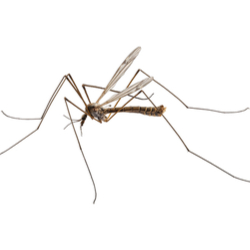Identification
- Colour Grey to brown
- Size From 15 mm to 25 mm long
- Also known as Daddy longlegs
- Description Have a long, thin body, with thin, smoky wings and extremely long legs.
- Notes Crane fly larvae are cylindrical, and look like worms, growing up to 4 cm long. They are often called leatherjackets, due to their tough skin.

Habitat, Diet, Lifecycle
Habitat
Crane flies are typically associated with moist vegetative habitats. Crane fly larvae can be found in moist soil feeding on decomposing vegetation and various plant roots. Some species may be found in streams feeding on small aquatic insects, invertebrates, and any decaying plant life found near the surface. They survive best in mild winters and cool summers, with adults emerging in late spring from lawns and pastures.
Diet
Adult crane flies do not feed. The larvae are the only feeding forms. They feed on roots of grasses and decaying organic matter. The food sources for the larvae remain abundant due to the regions the insects inhabit, including parts of Atlantic Canada and western provinces like British Columbia near the rainforests of the Pacific Northwest in the U.S.
Life Cycle
Like other true flies, the crane fly undergoes complete metamorphosis with four distinct stages, eggs, larva, pupa and adult. A female crane fly lays up to 300 eggs in the ground. The eggs hatch within two weeks of being deposited. The hatched larvae feed on decaying wood, vegetation, and turf, and may cause damage to plant roots in large concentrations. Typically, the crane fly larvae goes through four instars and overwinters under the ground before pupating in mid-to-late spring, just below the soil surface. When the adult crane flies emerge, they leave behind pupal cases (puparia) which appear to be small, grey sticks. Crane flies adults live for several days, typically just long enough to mate and reproduce.
Larvae
Crane fly larvae are sometimes called “leatherjackets” for the tough skin these insects exhibit during their third and fourth instars. Crane fly larvae feed on the roots of the grasses. Light grey to greenish-brown in colour, the larvae also exhibit irregular black specks on the body. They are cylindrical in shape and taper slightly at both ends. The larvae do not have legs and appear similar to worms. Crane fly larvae range in size from 5 mm in the first instar up to 4 cm in the final instar before pupation.
Why do I have crane flies
Crane flies like moist, vegetative, outdoor habitats, and are usually only seen around a home on external walls and window screens.
They lay their eggs in moist soil and when the larvae emerge, they feed on the roots of grasses, decaying organic matter, decaying wood, vegetation, and turf. Some larvae also feed on small aquatic insects, invertebrates, and any decaying plant life found near the surface of streams.
Adult crane flies don’t feed and live for only for a few days, just long enough to mate and reproduce.
How worried should I be about crane flies
Crane flies do not bite or sting humans, livestock, or pets, but can become a major pest to turf, pasture grass, golf courses, and field crops. This is due to their voracious larvae, which can leave grass yellow and thinning – and whole patches entirely bare.
Hatched larvae may cause damage to plant roots in large concentrations and attract more pests, like skunks, birds, and raccoons, who may try to dig up the ground in order to feed on them.
While adult crane flies have an extremely short lifespan, that doesn’t mean they can’t reproduce quickly. A female crane fly lays up to 300 eggs in the ground, all of which hatch into hungry larvae within two weeks.
To eliminate a crane fly infestation, you need to focus on their larvae. Registered insecticides can be effective, if used in late fall when eggs are laid and larvae are active. To be sure your crane fly infestation is over, a professional pest control service is essential.
How can I prevent crane flies invading
Maintain a healthy and vibrant turf or lawn, improve drainage soil is dry and aerated.
Do crane flies bite
As adult crane flies don’t bite or sting and live extremely short lives, homeowners should focus on eliminating the insects at the larval stage. Several things can be done to prevent crane fly infestations; maintaining a healthy and vibrant turf or lawn will make it less susceptible to the flies. Because crane flies lay eggs in wet soil and the eggs are vulnerable to desiccation, improving drainage to allow proper soil drying and aeration will prevent egg laying. If the eggs are already laid, they will still dry out. There are several registered products available in Canada that can applied as preventive treatment, but always remember to read and follow label instructions of the product. Insect-eating nematodes such as Steinernema species are also registered and available for use as biological control; they feed on the larvae. For severe infestations, consult a professional pest management specialist.
Other pests related to Crane flies
100% Satisfaction or Money Back Guarantee
Resolving your pest problem is our #1 priority. If re-treatment is required, we'll provide immediate services at no extra cost. If your expectations are not met, we guarantee a full refund of your service payment.
Remove pests from your home, and stop them from coming back
We work hard to listen, understand and assess your unique situation. Request a free, no-obligation estimate today for a customized pest program that fits your needs.
Request a Free Home EstimateRequest a Free Business Consultation

